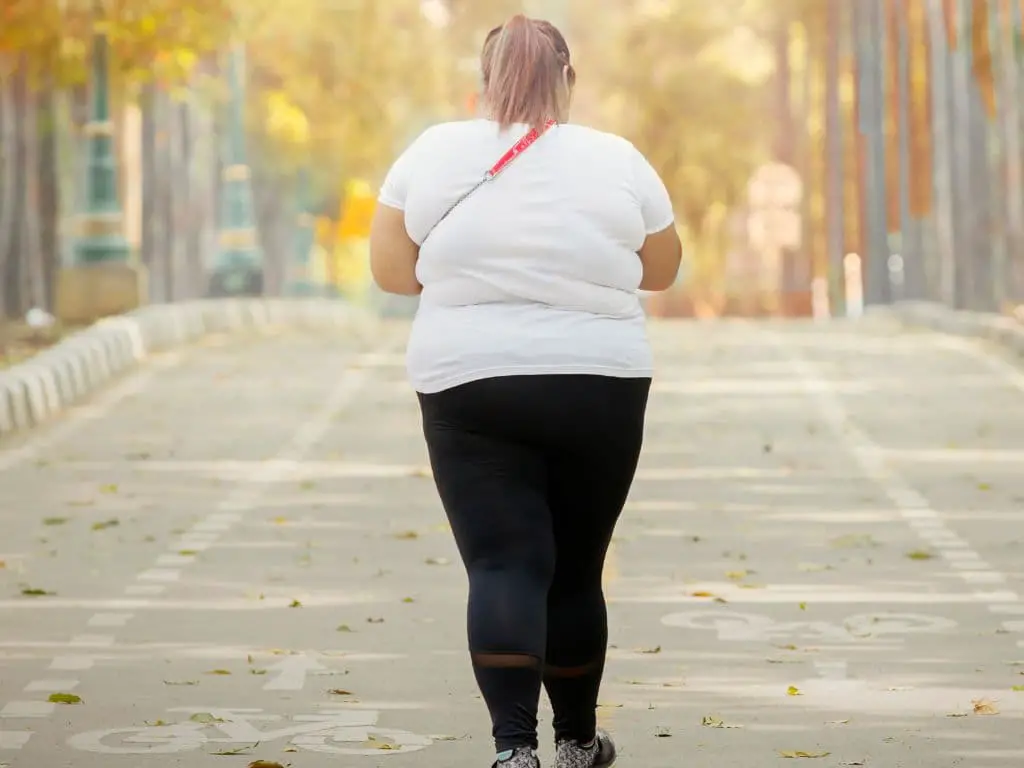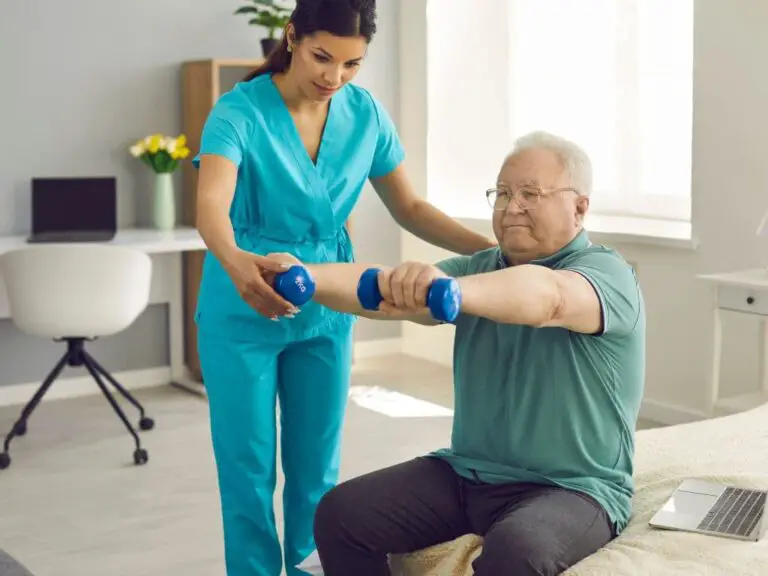How Long Should an Obese Person Walk?
Obesity is defined as having a body mass index (BMI) of 30 or higher. It is associated with many health risks including heart disease, diabetes, cancer, and osteoarthritis. As we age, maintaining a healthy weight becomes even more important to reduce disease risk and maintain quality of life.
How long should an obese person walk?
An obese person aiming to lose weight, should aim to work up to a minimum of 150 minutes of moderate-intensity aerobic activity per week, as recommended by health professionals. This equates to roughly 30 minutes of brisk walking five days a week. However, individuals should note that the exact amount of physical activity needed varies greatly and one may need more than the equivalent of 150 minutes of moderate-intensity activity per week to effectively lose weight.
For obese seniors, physical activity is a crucial component for improving health. It can help with weight loss and weight maintenance, while also providing cardiovascular, musculoskeletal, and mental health benefits. However, obese seniors need to be careful when starting new exercise programs, as their excess weight puts extra strain on joints.

This article will examine how much and what types of physical activity obese seniors should aim for, in order to improve health and manage weight. We’ll also look at safety considerations and tips for getting started.
Why Physical Activity is Important for Obese Seniors
- Improves cardiovascular fitness and lowers blood pressure
- Reduces joint pain and improves mobility
- Strengthens muscles and bones, preventing osteoporosis
- Reduces risk of diabetes, heart disease, stroke, and some cancers
- Improves balance and prevents falls
- Boosts mood and reduces symptoms of depression/anxiety
- Helps maintain independence and quality of life
For seniors trying to lose weight or keep weight off, physical activity is key. It increases calories burned, creating the calorie deficit needed for weight loss when combined with dietary changes. While weight loss mainly comes from reducing food intake, physical activity helps sustain weight loss over time.
Most importantly, physical activity reduces cardiovascular and diabetes risks beyond what is achieved by weight loss alone. Even small activity improvements can make big differences in the health of obese seniors.
How Much Physical Activity Is Recommended?
For general health:
- Aim for 150 minutes per week of moderate intensity physical activity
- This could be 30 minutes a day, 5 days a week of brisk walking
- 75 minutes per week of vigorous intensity activities like swimming laps also meets guidelines
For weight loss:
- More than 150 minutes per week is recommended for significant weight loss
- Unless calorie intake is also reduced, high volumes of activity are needed
- A good goal is 300 minutes per week of moderate-intensity activities
For weight maintenance after loss:
- Most weight loss occurs by decreasing calories consumed
- However, regular physical activity is vital for keeping weight off
- Aim for 200-300 minutes per week of moderate-intensity exercise
Exact needs vary greatly by individual. Those new to exercise should start slowly and increase duration over time. Consulting a doctor is wise to tailor a program to your health status and needs.
How Much to Walk According to BMI
The amount of walking needed to maintain a healthy weight or lose weight depends on a person’s BMI (body mass index). BMI is a measure of body fat based on height and weight.
The recommended amount of moderate physical activity like walking for most adults is 150 minutes per week. This can help prevent weight gain. But for meaningful weight loss, more exercise is needed.
The amount depends on your BMI:
Normal weight (BMI 18.5-24.9)
To maintain weight – 150 minutes per week of moderate activity like brisk walking.
For weight loss – Add 60-90 minutes of moderate activity per day.
Overweight (BMI 25-29.9)
To maintain weight – 200-300 minutes per week of moderate activity.
For weight loss – Gradually build up to 300 minutes per day of activity.
Obese (BMI 30+)
To maintain weight loss – 300+ minutes per week of moderate activity.
For weight loss – Start with 30 minutes per day and build up to 60-90 minutes of brisk walking daily.
Sure, I’ll create a table summarizing the recommended amounts of physical activity based on BMI for weight maintenance and weight loss:
| BMI Category | Weight Maintenance (per week) | Weight Loss (per day) |
|---|---|---|
| Normal Weight (BMI 18.5-24.9) | 150 minutes of moderate activity like brisk walking | Add 60-90 minutes of moderate activity |
| Overweight (BMI 25-29.9) | 200-300 minutes of moderate activity per week | Gradually build up to 300 minutes of moderate activity per day |
| Obese (BMI 30+) | 300+ minutes of moderate activity per week | Start with 30 minutes per day and build up to 60-90 minutes of brisk walking daily |
Here’s a separate section for the recommended steps per day:
| Activity Level | Steps per Day |
|---|---|
| Sedentary | Less than 5,000 steps |
| Low activity | 5,000-7,499 steps |
| Somewhat active | 7,500-9,999 steps |
| Active | 10,000-12,499 steps |
| Highly active | More than 12,500 steps |
Walking is an excellent fat burning exercise. The more steps per day, the better. Use a pedometer or fitness tracker to monitor steps. Aim for 5,000-10,000 steps per day depending on current activity level.
Here are the calories burned per hour from walking at a moderate pace of 3-4 mph for different weights:
| Weight (lbs) | Calories Burned/Hour |
|---|---|
| 120 | 210 |
| 150 | 260 |
| 180 | 315 |
| 210 | 365 |
In summary, the recommended amount of walking for weight loss depends on your BMI. Focus on gradually increasing daily steps and building up to 60-90 minutes per day of brisk walking. Combining daily physical activity with a calorie-controlled diet can lead to successful weight management over time.
What Counts as Moderate vs. Vigorous Intensity?
Moderate intensity:
- Noticeably faster heart rate, breathing, but can hold a conversation
- Brisk walking, light yard work, casual biking
- Equivalent to about 3-6 METs (metabolic equivalents)
Vigorous intensity:
- Heart rate and breathing increased substantially
- Too challenging to maintain conversation
- Jogging, swimming laps, competitive sports
- Equivalent to >6 METs
Calories Burned During Common Activities
| Activity | Moderate Effort (3-6 METs) | Vigorous Effort (>6 METs) |
|---|---|---|
| Walking (15 min mile) | 225 calories/hour | 300 calories/hour |
| Yard work like raking | 180 calories/hour | 240 calories/hour |
| Actively playing with kids | 210 calories/hour | 300 calories/hour |
| Biking casual pace | 225 calories/hour | 400 calories/hour |
| Jogging/running | – | 590 calories/hour |
| Swimming laps | – | 510 calories/hour |
| Jumping rope | – | 700 calories/hour |
Safety Considerations for Obese Seniors
Because obese seniors carry extra weight, certain precautions should be taken when exercising:
- Start with short sessions (10-15 minutes) and increase gradually
- Low-impact activities like walking, swimming, and biking are easiest on joints
- Listen to body signals – take breaks as needed
- Stay hydrated and wear supportive footwear
- Use canes/walkers if needed for balance and stability
- Avoid high-impact activities that jar joints like jumping
- Take care on uneven surfaces that increase fall risk
- Monitor heart rate and breathing, don’t overexert
Having a chronic condition like arthritis, diabetes, or heart disease means discussing exercise plans with your doctor. Certain activities or intensities may need to be avoided. Being cleared for exercise ensures safety.
Tips for Getting Started
Beginning a new exercise program can be daunting. Here are some tips for obese seniors to get started safely:
- Consult your physician – get medical clearance
- Start with 5-10 minute sessions, increase gradually
- Walking is a great beginner activity – go at your own pace
- Break sessions up into smaller chunks if needed
- Find activities you enjoy – you’ll stick with them longer
- Be patient – fitness gains take time
- Recruit a buddy for encouragement and accountability
- Listen to your body – don’t push through joint pain
- Monitor intensity – talk test ensures not overexerting
- Celebrate small achievements – they’ll motivate you
Conclusion
Physical activity provides obese seniors with wide-ranging health benefits, from obesity and disease risk reduction to better mobility and mental health. While exact needs vary, strive for at least 150 minutes per week of moderate-intensity exercise. Activities like brisk walking, swimming, water aerobics, or gentle cycling and strength training are great options.
Start slowly, be patient with yourself, and consult your doctor. With time, the right amount of physical activity can help obese seniors lose weight, sustain weight loss, reduce medication needs, and maintain independence. Most importantly, physical activity can add healthy years to seniors’ lives.
Frequently Asked Questions
-
How long should an obese person walk?
A slower pace (3 miles per hour) may prove more helpful for obesity patients than walking 2 miles/hour. Researchers say that walking slow may be more effective for obese people than walking faster. However, it does not have any cardiovascular benefits.
-
What is the life expectancy of people with obesity?
According to research from Oxford University, moderate obesity can reduce life expectancy by 3 years. Severe obesity is rare, but it can cut down a person’s lifespan by up to 10 years.
-
What is considered Class 3 obesity?
Class 3: A BMI greater than 40. Sometimes, class 3 obesity can be referred to as severe obesity.
-
How do you get rid of belly fat after 65?
For those who want to lose belly fat, building muscle mass is key. Harvard Health Publishing estimates that adults could lose between 3 and 5 percent of their muscle mass every decade by the age of 30. This may partially explain the slowing down of metabolism as we age, and the increase in abdominal fat.
-
How do I burn fat while lying down?
One of the best ab exercises is reverse crunches. With your knees bent, Lie down on your stomach and bend your knees to 90 degrees. Keep your hips elevated off the ground by slowly clenching your knees. For a second, pause at the top and then slowly lower down.
-
What do 90 year olds eat?
Healthy eating plans emphasize fruits, vegetables, whole grain, low-fat and fat-free milk. They include lean meats, poultry, fish and eggs, as well as legumes, nuts, and are low in trans fats and saturated fats. It doesn’t need to be difficult to eat right.
-
What is the new treatment for obesity?
The U.S. Food and Drug Administration has approved Wegovy (semaglutide), an injection of 2.4 mg per week, for the management of chronic weight in overweight adults (or those with at least one obesity-related condition, such as type 2 diabetes or high cholesterol) and for reduced dosage.
-
Which sleeping position burns the most calories?
Deep sleep causes your body to burn more calories. The longer you stay asleep soundly, and the less calories you’ll burn, the better. Because your brain works best in deep or REM sleep, this is why you will burn more calories.
-
How should an obese person start exercising?
You can lose weight by choosing activities that are easy on the joints. Break down your exercise routine into small chunks if 150 minutes per week seems daunting. You should aim to exercise 30 minutes per day on five different days each week.
-
How can a 74 year old lose weight?
Consume a diet rich in fruits and vegetables. Vitamin D is the most essential nutrients, while protein and other vitamins are also important. Because fruits and vegetables are high in water and fiber, it would be a good idea to create a diet that helps you lose weight.
-
How do I get rid of my apron belly?
Remember that overall health should be the top priority. Any exercise and eating plan must focus on this. An apron stomach is difficult to treat. The only ways to reduce one are through overall weight reduction and surgical/non-surgical options.
-
What is the life expectancy of someone with obesity?
Multiadjusted life expectancy in men was highest for those who were overweight (44.34 years; 95% CI 43.11-45.54, P=0.0264), then normal weight (44.33 years, 42.22–43.73), and obesity (41.36 to 44.70; p=0.3184), and shortest for those who are underweight (37.50 to 38.87, P0.0001).
-
What is the best diet for over 65?
You can eat a variety of food from each of the five food categories: lots of colorful vegetables and legumes/beans, fruit, grain (cereal), foods that are mostly wholegrain or high in fibre, lean meats, poultry, fish and eggs, as well as nuts, seeds, milk, yogurt, and cheese, with a lot of reduced fat.
-
Will I gain weight if I eat 2 eggs a day?
Eggs, especially breakfast, are a great addition to healthy weight loss. The egg does not cause weight gain. What aids weight gain is the caloric surplus. You will gain weight if you eat more eggs than you need.
-
How do I lose weight at 70?
These golden rules still hold true for weight loss: Eat less calories than what you drink or eat. Increase your intake of vegetables, fruits, legumes, low-fat and fat-free milk, as well as whole grains and fish. Keep meat and poultry lean. Avoid empty calories such as sugars, and avoid foods that have little or no nutritional value.







